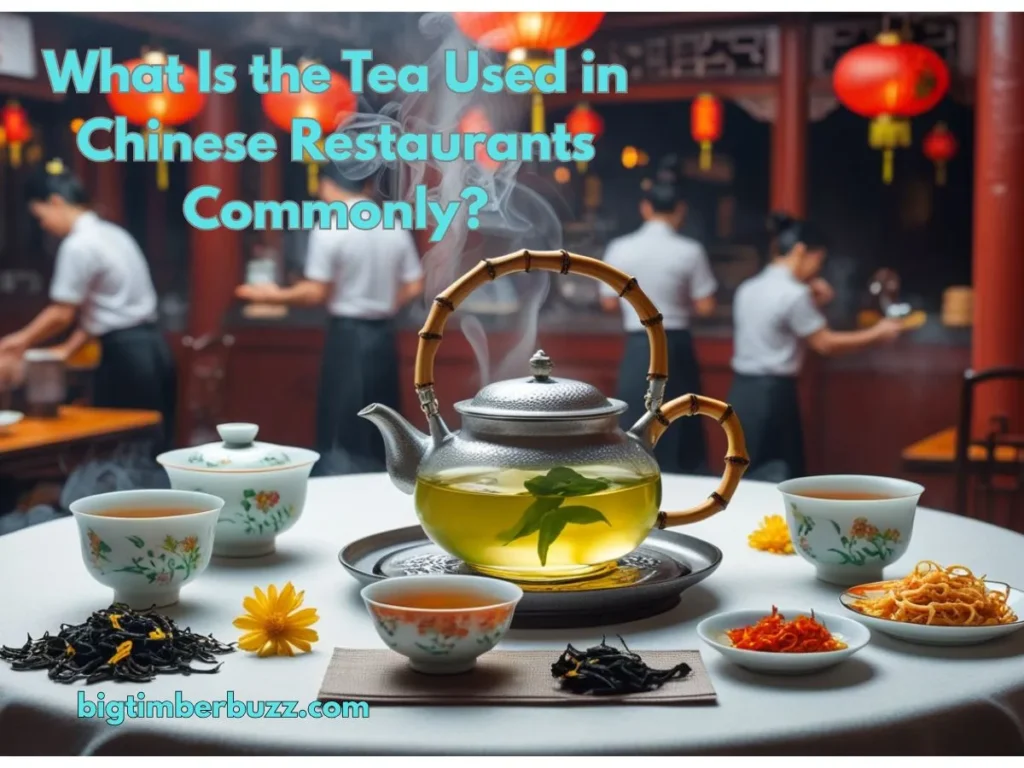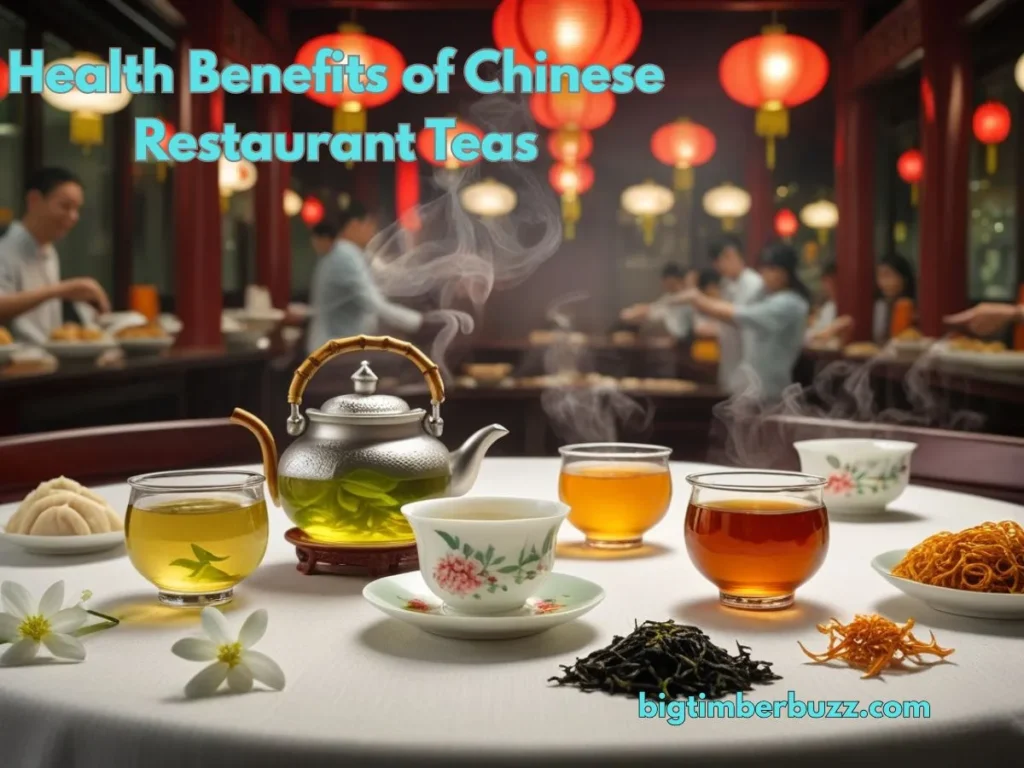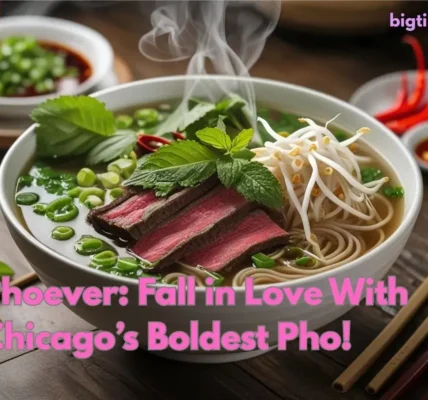Introduction
Have you ever had that hot, aromatic tea you get at a Chinese restaurant and wondered, ‘What is the Tea Used in Chinese Restaurants?’ You’re not alone!
That lovely glass, which is often provided at no cost, can enhance every bite of dim sum or spicy noodles. Most Chinese restaurants will serve you jasmine, green, or oolong tea, all selected for their distinctive flavors and cultural relevance.
In this complete guide, we’re going to reveal what is the tea used in Chinese restaurants serve, how to brew it at home, its benefits, and where to source genuine brands. And take a journey through Chinese restaurant tea!
What Is the Tea Used in Chinese Restaurants Commonly?

Chinese restaurants choose teas to complement their dishes and enhance your dining experience. The following are the leading teas in which you’ll find them:
Jasmine Tea: The Floral Favorite
Chinese restaurants are where jasmine tea shines, particularly at dim sum parlors. It has a smooth, floral flavor made up of green tea leaves and jasmine flowers.
It’s great for clearing the palate between rich, fried dishes, such as fried dumplings. Tea experts note that it is most widely use to counteract greasy flavors.
Green Tea: Crisp and Refreshing
Green tea has a light, grassy flavour which is why it is popular within the Cantonese. Hot, it accompanies dishes that are light such as steamed fish.
With its high levels of antioxidants, it supports digestion, a prime reason why it’s a staple of Chinese cuisine.
Oolong Tea: Bold and Complex
Oolong tea, with its fruity, bold flavors, is a star at upscale restaurants. It falls somewhere between green and black tea, and is perfect alongside a rich dish, like braised pork. Its versatility makes it one our favorites to do a real Chinese tea session.
Other Teas: Pu-erh and Black Tea
Some restaurants pour pu-erh tea (earthy, fermented) or black tea (malty, bold). Pu-erh is often used in Sichuan kitchen for its digestive advantages, while black tea brings variety to northern restaurants.
Why These Teas Are Chosen for Chinese Restaurants
What Is the Tea used in Chinese Restaurants? Do they have jasmine, green , or oolong tea? It’s about tradition and flavor.
For thousands of years, tea has been a cornerstone of Chinese tea culture, which aids digestion and lends tea its distinctive flavor. Here’s why these teas get the nod:
- Cultural base: Tea is a token of hospitality, whereby it can be offer without charge to the visitor.
- Flavor Balance: Jasmine tea stands up well to an oily dish, green tea pairs nicely with light flavors and an oolong will elevate a spicy Sichuan dish.
- Digestive Aid: Teas such as pu-erh and green help settle the stomach after rich meals.
That tradition stems from the tea houses of old, where tea is use to build community.
The Role of Tea in Chinese Dining Culture
Are you wonder what is the Tea Used in Chinese Restaurants? In Chinese restaurants, tea is more than just a beverage; it is an act of ritual. Tea has been at the heart of Chinese society for centuries, and tea ceremonies teach mindfulness and respect.
In restaurants, tea serves to set a pleasant tone, and it’s commonly poures before menu decisions are made. In Cantonese dim sum houses, for example, servers provide jasmine tea to accompany savory buns.
Pu-erh tea helps with digestion after eating the hot, spicy mapo tofu of Sichuan; goat worsens the laurel. This tea culture embodies harmony and involves sharing tea at the table to enjoy the taste together.
How to Brew Chinese Restaurant Tea at Home
Love Chinese restaurant tea? Here it is to break down, if you’d like to make it at home:
- Select Nice Tea: Use loose-leaf jasmine, green, or oolong tea from a brand like Ten Ren.
- Heat Water Just Right: Use 175°F for jasmine, 185°F for green, 195°F for oolong.
- How to Make Your Tea: A warm teapot is recommended. Add 1 tsp of tea per cup, cover with boiling water, and let it steep for 1-3 minutes to prevent your tea from becoming bitter.
- To Serve Traditionally: Pour into small cups or a sharing pot.
Tips for Success:
- Serve in a gaiwan (lidded teacup) for a more authentic touch.
- To flavor the leaves, rinse them briefly with hot water.
- Steep the tea to taste.
| Tea Type | Water Temp | Steep Time | Flavor Profile |
| Jasmine Tea | 175°F | 1-2 min | Floral, smooth |
| Green Tea | 185°F | 1-3 min | Crisp, grassy |
| Oolong Tea | 195°F | 2-3 min | Bold, fruity |
Health Benefits of Chinese Restaurant Teas

What Is the Tea Used in Chinese Restaurants to maintain health? The health benefits of Chinese restaurant tea also contribute to its attractiveness.
Here’s what each offers:
- Jasmine Tea: The soothing scent lowers stress, according to aroma therapy research.
- Green Tea: Catechins in green tea enhance heart health and metabolism (PubMed, 2020).
- Oolong Tea: Polyphenols aid in digestion and weight loss.
- Pu-erh Tea: Fosters gut health (great for big meals).
These reasons make tea in Chinese restaurants a healthy option.
Where to Buy Authentic Chinese Restaurant Tea
For genuine Chinese tea to enjoy at home, purchase from reliable vendors:
- Ten Ren: High-grade jasmine and oolong teas are easy to find.
- Harney & Sons: High-quality green tea blends and restaurant-grade flavor.
- Teavivre: Specializes in oolong and pu-erh with origin information.
- Amazon: For diverse options with customer reviews you can trust.
Buying Tips:
- Source: Fujian for oolong, Zhejiang for green tea.
- Whole-Leaf Tea: The better way to tea.
- Read Reviews: For quality and authenticity.
| Brand | Tea Type | Price (per oz) | Where to Buy |
| Ten Ren | Jasmine | $5-10 | TenRen.com, Amazon |
| Harney & Sons | Green | $6-12 | Harney.com, Amazon |
| Teavivre | Oolong | $8-15 | Teavivre.com |
Pairing Tea with Chinese Food
Tea is a great complement to Chinese cuisine. Try these:
- Jasmine Tea: To stave off grease (shrimp dumplings, et) served with dim sum.
- Green Tea: Steamed fish or bok choy for levity.
- Oolong Tea: From spicy mapo tofu to mellow heat.
- Pu-erh Tea, with braised pork belly to help digestion.
These marriages enhance the flavours and create a memorable dining experience.
Comparing Chinese Restaurant Tea Brands
Craving authentic ? What is the Tea Used in Chinese Restaurants and homes? The secret to capturing that restaurant taste is selecting the right brand.
In this guide, we compare leading brands that offer jasmine, green, and oolong teas to Chinese restaurants in terms of quality, taste, and value. These are all names you can rely on to deliver the true Chinese tea taste at home.
- Ten Ren: Famous for high-end jasmine tea and oolong tea. Its dragon well green tea is restaurant-style crisp. It’s source from Taiwan, and a favorite for dim sum restaurants.
- Harney & Sons: Known for green tea blends with grassy undertones, which you will want for Cantonese dishes. Their teas are cheap and ubiquitous.
- Teavivre: High-quality oolong tea and pu-erh tea from Fujian use it at upscale restaurants, was on offer. Their teas are all about terroir and leaf grade.
- Adagio Teas: Offers reasonably priced jasmine and green teas that I personally find to be quite nice for home brewing.
| Brand | Tea Type | Price (per oz) | Taste Profile | Best For |
| Ten Ren | Jasmine, Oolong | $5-10 | Floral, bold | Dim sum pairing |
| Harney & Sons | Green | $6-12 | Grassy, light | Steamed dishes |
| Teavivre | Oolong, Pu-erh | $8-15 | Fruity, earthy | Spicy cuisine |
| Adagio Teas | Jasmine, Green | $4-8 | Smooth, balanced | Budget buyers |
How to Choose the Right Brand: You’re looking for whole-leaf teas from places like Fujian and Zhejiang. Read customer reviews for authenticity and flavor uniformity.
Common Myths About Chinese Restaurant Tea
Ever wonder what is the tea used in Chinese restaurants? Here, we dispel some common myths to break the confusion of what this tea served in most Chinese restaurants is:
- Myth 1: All restaurant tea is crap. Many restaurants offer premium jasmine, green, or oolong teas sourced from reputable suppliers like Ten Ren. Quality is all over the map, but integrity is rife.
- Myth 2: It’s free, so tea is inexpensive. Free tea is a traditional Chinese tea culture, a sign of hospitality, not a low price. While dining, rich and flavorful teas are often selected.
- Myth 3: Every Chinese restaurant serves the same tea. Tea can vary by region at Cantonese spots; it’s likely to be green tea, and at Sichuan restaurants, pu-erh tea may be available.
- Myth 4: Tea brewed at restaurants is not good for you. Health benefits of Chinese restaurant tea include antioxidants (such as those found in green tea) and digestive aid properties (as seen in pu-erh), supported by scientific studies.
These facts help you understand how tea is served in a Chinese meal.
Curious about more food traditions and flavors from around the world? Discover fresh insights, tasty guides, and culinary stories at Big Timber Buzz your go-to destination for all things delicious!
Conclusion
What tastes like a foostery Oriental Restaurant Tea, the jasmine, long, or pu-erh used in Chinese restaurants that sends these goons through dinner bursting with flavor and the stamp of cultural legacy.
Jasmine’s floral notes complement dim sum, for example, while oolong, rich and toasty, is suited to heartier dishes. Pu-erh’s loamy depth helps aid digestion after meals.
Pu-erh’s earthy depth aids digestion after meals. Brewed fresh from loose leaves, what is the tea used in Chinese restaurants reflects warm hospitality. You can try this for yourself using high-quality leaves from FarmerTeas and traditional brewing methods.
Effect: You’ll savor the extra flavor this tea brings to the table as you enjoy old-world Chinese traditions in a new world cup. Take the plunge into this cultural tradition and savor the real taste today!
FAQs
What Is the Tea Used in Chinese Restaurants?
Jasmine tea, for taste and digestion. (followed by green, and then oolong).
Is Chinese restaurant tea healthy?
Yes, antioxidants in green and oolong teas can promote heart and gut health.
Can I buy restaurant-style tea?
Yes, Ten Ren, Teavivre, or Amazon.
Why is tea free in Chinese restaurants?
It’s a tradition of hospitality steeped in the Chinese tea culture.








